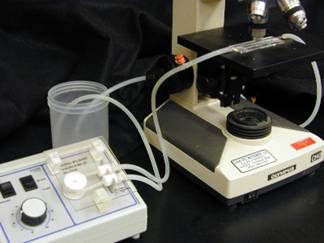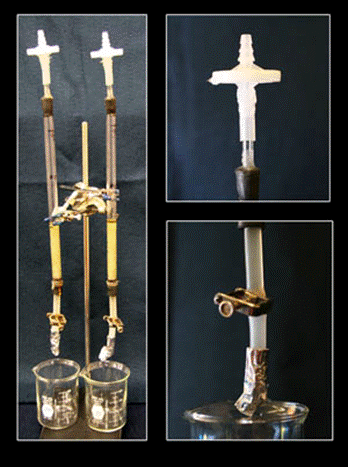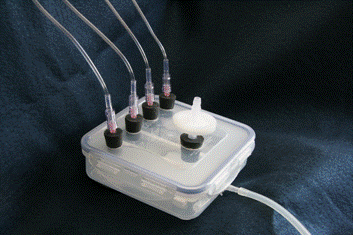Reactor Theory and Practice
Plug Flow Reactor (PFR)
The third general type of reactor is the Plug Flow Reactor (PFR). In a plug flow reactor, nutrients (and sometimes organisms) are introduced to the reactor continuously and move through the reactor as a “plug”. The system may be either contained (as in a water main, oil pipeline, or blood vessel) or open (as in a shower curtain, stream, or canyon seep).
In an ideal plug flow reactor, it is assumed that there is no mixing of the medium along the long axis (X-axis) of the reactor although there may be lateral mixing in the medium at any point along the long axis (ie the Y-axis).
Due to the metabolic activity of the organisms in the biofilm, constituents of the reactor will change as medium flows along the long axis due to consumption of nutrients and elimination of waste products. The nutritional conditions at any given point along this long axis should, however, remain constant in a stable reactor. On the other hand, as an organism moves through the PFR it encounters constantly changing concentrations of nutrients, oxygen and waste products.

The Biofilm exercise collection contains several reactors that are of the Plug Flow variety. One very useful and instructive plug flow reactor is the Flow Cell. Flow cells have been used to investigate the growth of biofilms in real time on the stage of a microscope. Exercise 4 in the collection describes the construction of a flow cell from optical quality square capillary tubes (Exercise 4 - Building and Using a Flow Cell Biofilm Reactor).

attached to a peristaltic pump.
The flow cell has provision for introducing additional organisms, biocides, nutrients or dyes while the cell is in operation. If one wishes to observe biofilms growing in as close to a natural environment as possible, this is the exercise for you. One very instructive use of the flow cell is to pump water from an established aquarium continuously through the cell while observing the walls of the cell microscopically. One can observe in real time attachment, micro-colony formation and the effects of fluid flow. The observation of the viscoelastic properties of mature biofilms as long streamers wave back and forth in the current is unforgettable.
Sometimes liquid passes in a plug flow mode through a porous matrix such as soil, sand or porous rock. Biofilms initiated in such a matrix can be used to slow the rate of flow of contaminants through the matrix in what is called a biobarrier. Furthermore, if the appropriate organism is available, that is, one that can metabolize the contaminating substance, biobarriers can be used to remediate the contaminate reducing the concentration of contaminating material. Exercise 14 (Biofilms as Biobarriers) in the collection describes the construction and operation of a biobarrier. This exercise is appropriate for general microbiology but might be of particular interest to students in environmental science or engineering.

Figure 3. Left -Two biobarrier columns, packed with 3 mm glass
beads and inoculated with Pseudomonas fluorescence
Right - Detail of the air filter and drain assembly
The plug flow reactors describe above may be described as “closed”, in that they are enclosed in a pipe-like geometry. Another sort of plug flow reactor could be described as “open”. A shower curtain, the walls of a bathtub, or a canyon wall seep all exhibit the properties of an open plug flow reactor.
This sort of reactor geometry is quite common in nature in any habitat where water flows over a surface either continuously or intermittently. One type of reactor designed to model these conditions is the Drip Flow Reactor (DFR). Drip flow reactors typically produce biofilms grown under low-shear and laminar flow conditions.

below seeps at White House ruins in
Canyon de Chelly National Monument, AZ.
Of course, drip flow reactors are commercially available (for example, http://www.imt.net/~mitbst/Drip_Flow_Reactor.html), but they are prohibitively expensive for most teaching laboratories. A new exercise in the biofilm laboratory collection (Exercise 20 - Construction of a Drip Flow Reactor) describes the construction of a drip flow reactor from a readily available storage container and other inexpensive and generally available materials. This reactor is not autoclavable but can be disinfected in a 1/10 Clorox® bath.

Goeres et al. list the following characteristics of drip flow reactors3:
- The biofilm forms close to the air liquid interface simulating environments such as the oral cavity, wet rock surfaces, and shower curtains.
- Surfaces within the reactor experience mild shear (low fluid velocity over the surface) which yields a biofilm that has a smooth appearance and is loosely attached and microscopically has few architectural details.
- The residence time in the reactor is typically short.
- The biofilm can be easily analyzed using various techniques including viable plate counts, light microscopy, and thickness determination.
- This reactor type produces a uniform biofilm under low shear that can be used like the static glass coupon reactor (no shear) to test microbicide effectiveness.
